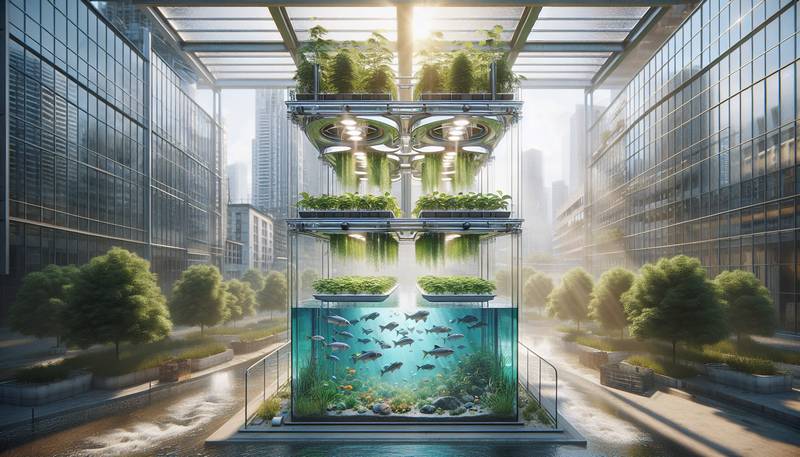Aquaponics: Sustainable Farming for Urban Areas

Introducing Aquaponics: Yesterday's Fish Tank, Today's Food FactoryImagine a world where fish and plants coexist in a symbiotic relationship – no, I'm not describing the Little Mermaid's kingdom, but rather the fascinating world of aquaponics. This sustainable farming method is revolutionizing urban agriculture and turning your average city slicker into an urban farmer faster than you can say "kale smoothie."Aquaponics 101: How it WorksAquaponics is a combination of aquaculture (raising fish) and hydroponics (growing plants without soil). In this ingenious system, the fish provide nutrients for the plants, and the plants clean the water for the fish, creating a closed-loop, self-sustaining ecosystem. Now, let's break it down a bit. Fish produce waste – that's right, the fish are the unsung heroes of this story. This waste contains ammonia, which is toxic to our finned friends. But fear not, for in this story, Mother Nature provides us with bacteria that convert this ammonia into nitrites and then into nitrates, which are fantastic plant food. The plants, in turn, absorb these nitrates, essentially "cleaning" the water, which can then be safely returned to the fish tank.Why Aquaponics is the Future of Urban AgricultureMove over, rooftop gardens and community plots – aquaponics is the cutting-edge solution to sustainable urban farming. It's environmentally friendly, space-efficient, and incredibly productive. Allow me to count the ways:- Water efficiency: In an age of water scarcity, aquaponics uses up to 90% less water than traditional soil-based farming. A closed-loop system means that water is continually recycled, with only a small amount of water added to replace what's lost to evaporation.
- Space-saving: By stacking grow beds vertically, you can grow a veritable jungle of fruits and veggies in a small footprint. Perfect for urban dwellers with limited space, this method can turn a tiny balcony or rooftop into the Garden of Eden.
- No harsh chemicals: Pesticides and herbicides are a big no-no in aquaponics, as they would harm the fish. Luckily, with a healthy ecosystem, pests are naturally kept at bay. Plus, harmful fertilizers are already out of the equation, as the fish waste provides all the nutrients the plants need.
- Year-round production: Aquaponics can be done indoors or outdoors, allowing for continuous food production regardless of the season. Greenhouses can be fitted with aquaponic systems to create a tropical paradise in the dead of winter. Take that, Old Man Winter!
- High yields: The constant supply of water and nutrients in aquaponics means plants grow faster and produce more food than their soil-based cousins. And let's not forget the fish – they too can be harvested for a delicious, protein-rich meal.
Getting Started with Your Own Aquaponic SystemSo, you're hooked (pun intended) and ready to dive into the deep end of aquaponics. Fear not, intrepid urban farmer, for setting up your own system is easier than you might think:- Choose your fish: You'll need to select fish that are suitable for your climate and space. Tilapia, goldfish, and koi are popular choices, but don't be afraid to get creative and consult with your local fishmonger for advice.
- Set up your tank: It's essential to provide a healthy environment for your fish, with proper filtration, aeration, and temperature control. Depending on your space, you can opt for a small aquarium or a larger outdoor pond. Remember, the bigger the tank, the more fish you can raise, and the more plants you can grow.
- Grow beds: Here's where your green thumb comes into play. You'll want to choose a growing medium – such as expanded clay pebbles or coconut coir – that allows for proper water flow and root growth. Then, plant your favorite fruits and veggies and watch them flourish!
- Maintain the balance: It's important to regularly test the water quality and monitor the health of your fish and plants. With time and experience, you'll become a master at fine-tuning your system for optimum results.
Embrace the Aquaponic Revolution!With the rise of urbanization and the need for more sustainable food sources, aquaponics offers a viable solution for city dwellers looking to cultivate their own fresh, organic produce (and fish!). So, join the movement, and transform your concrete jungle into a thriving, green oasis. And who knows, perhaps one day we'll look back on these early days of aquaponics as the first small steps towards a global shift in how we grow our food. Now, if only we could figure out a way to get the fish to sing catchy tunes while they work…
|
|







